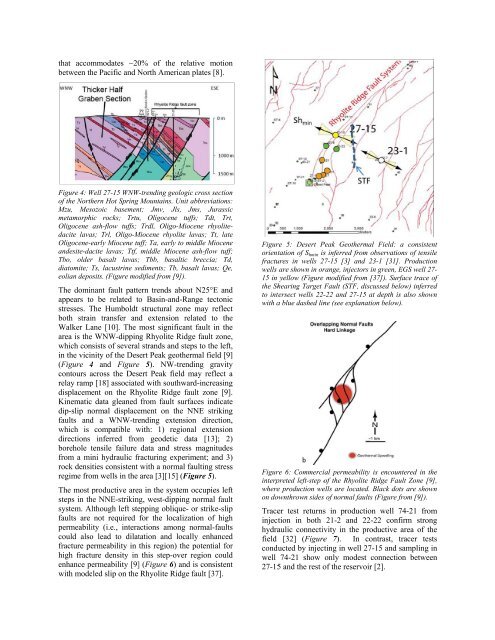computational investigation of hydro-mechanical effects on ...
computational investigation of hydro-mechanical effects on ...
computational investigation of hydro-mechanical effects on ...
Create successful ePaper yourself
Turn your PDF publications into a flip-book with our unique Google optimized e-Paper software.
that accommodates ~20% <str<strong>on</strong>g>of</str<strong>on</strong>g> the relative moti<strong>on</strong><br />
between the Pacific and North American plates [8].<br />
Figure 4: Well 27-15 WNW-trending geologic cross secti<strong>on</strong><br />
<str<strong>on</strong>g>of</str<strong>on</strong>g> the Northern Hot Spring Mountains. Unit abbreviati<strong>on</strong>s:<br />
Mzu, Mesozoic basement; Jmv, Jls, Jms, Jurassic<br />
metamorphic rocks; Trtu, Oligocene tuffs; Tdt, Trt,<br />
Oligocene ash-flow tuffs; Trdl, Oligo-Miocene rhyolite-<br />
dacite lavas; Trl, Oligo-Miocene rhyolite<br />
lavas; Tt, late<br />
Oligocene-early Miocene tuff; Ta, early to middle Miocenee<br />
andesite-dacite lavas; Ttf, middle Miocene ash-flow tuff; f;<br />
Tbo, older<br />
basalt lavas;<br />
Tbb, basaltic<br />
breccia; Td,<br />
diatomite; Ts, lacustrine sediments; Tb, basalt lavas; Qe,<br />
eolian deposits. (Figure modified from [9]).<br />
The dominant fault pattern trends about N25°E and<br />
appears to<br />
be related to<br />
Basin-and-Range tect<strong>on</strong>icc<br />
stresses. The Humboldt structural z<strong>on</strong>e may reflect<br />
both strain<br />
transfer and extensi<strong>on</strong> related to the<br />
Walker Lane [10]. The most significant fault in the<br />
area is the WNW-dipping Rhyolite Ridge fault z<strong>on</strong>e,<br />
which c<strong>on</strong>sists <str<strong>on</strong>g>of</str<strong>on</strong>g> several<br />
strands and steps to the left,<br />
in the vicinity <str<strong>on</strong>g>of</str<strong>on</strong>g> the Desert Peak geothermal field [9]<br />
(Figure 4 and Figure<br />
5). NW-trending gravity<br />
c<strong>on</strong>tours across the Desert Peak field may reflect a<br />
relay ramp<br />
[18] associated with southward-increasing<br />
displacement <strong>on</strong> the Rhyolite Ridge fault z<strong>on</strong>e [9].<br />
Kinematic data gleaned from fault surfaces indicate<br />
dip-slip normal displacement <strong>on</strong> the NNE striking<br />
faults and<br />
a WNW-trending extensi<strong>on</strong> directi<strong>on</strong>,<br />
which is compatible with: 1) regi<strong>on</strong>al extensi<strong>on</strong>n<br />
directi<strong>on</strong>s inferred from<br />
geodetic data [13]; 2)<br />
borehole tensile failure data and stress magnitudes<br />
from a mini hydraulic fracturing experiment; and 3)<br />
rock densities c<strong>on</strong>sistent with a normal faulting stresss<br />
regime from<br />
wells in the area [3][15] (Figure 5).<br />
The most productive area in the system<br />
occupies left<br />
steps in the NNE-striking, west-dipping normal fault<br />
system. Although left stepping oblique- or strike-slip<br />
faults are not required for the localizati<strong>on</strong> <str<strong>on</strong>g>of</str<strong>on</strong>g> highh<br />
permeability (i.e., interacti<strong>on</strong>s am<strong>on</strong>g<br />
normal-faults<br />
could also<br />
lead to dilatati<strong>on</strong> and locally enhanced<br />
fracture permeability in this regi<strong>on</strong>) the potential for<br />
high fracture density in this step-over<br />
regi<strong>on</strong> could<br />
enhance permeability [9]<br />
(Figure 6) and is c<strong>on</strong>sistentt<br />
with modeled slip <strong>on</strong> the Rhyolite Ridge fault [37].<br />
Figure 5: Desert Peak Geothermal Field: a c<strong>on</strong>sistent<br />
orientati<strong>on</strong> <str<strong>on</strong>g>of</str<strong>on</strong>g> S hmin iss inferred from observati<strong>on</strong>s <str<strong>on</strong>g>of</str<strong>on</strong>g><br />
tensile<br />
fractures in wells 27-15 [3] and 23-1 [31]. Producti<strong>on</strong><br />
wells are shown in orange, injectors in green, EGS well 27-<br />
15 in yellow (Figure modified from [37]). Surface trace <str<strong>on</strong>g>of</str<strong>on</strong>g><br />
the Shearing Target Fault (STF, discussed below) inferred<br />
to intersect wells 22-22 and 27-15 at depth is also shown<br />
with a blue dashed line (see explanati<strong>on</strong> below).<br />
Figure 6: Commercial permeability is encountered<br />
in the<br />
interpreted left-step <str<strong>on</strong>g>of</str<strong>on</strong>g> the Rhyolite Ridge Fault Z<strong>on</strong>e [9],<br />
wheree producti<strong>on</strong> wells are located. Black dots are shown<br />
<strong>on</strong> downthrown sidess <str<strong>on</strong>g>of</str<strong>on</strong>g> normal faults<br />
(Figure from [9]).<br />
Tracer test returnss in producti<strong>on</strong> well 74-21 from<br />
injecti<strong>on</strong> in both 21-2 and 22-22 c<strong>on</strong>firm str<strong>on</strong>g<br />
hydraulic c<strong>on</strong>nectivity in the productive area <str<strong>on</strong>g>of</str<strong>on</strong>g> the<br />
field [32] (Figuree 7). In c<strong>on</strong>trast, tracerr tests<br />
c<strong>on</strong>ducted by injecting in well 27-15 and sampling in<br />
well 74-21 show <strong>on</strong>ly modest c<strong>on</strong>necti<strong>on</strong> between<br />
27-155 and the rest <str<strong>on</strong>g>of</str<strong>on</strong>g> the reservoirr [2].
















